El Salvador 1979 "Prehistoric Fauna from El Salvador"
| <prev | back to index | next> |
| Issue Date | 07.09.1979 |
| ID | Michel: 1289-1294; Scott: 911-913, C458-C460. Stanley Gibbons: 1611-1616. Yvert: 859-861, air mail 434-436 Category: pR |
| Design | |
| Stamps in set | 6 |
| Value |
Land mail: c10 - Mastodon (Gomphotherium) c20 - Smilodon sp. c30 - Toxodon platensis Air mail: c15 - Mammuthus columbi (the Columbian mammoth) c25 - Eremotherium carolinensis $2.0 - Borophagus cynoides |
| Emission/Type | commemorative |
| Places of issue | |
| Size (width x height) | |
| Layout | |
| Products | FDCx 1 |
| Paper | |
| Perforation | 14x14.5 |
| Print Technique | Offset lithography |
| Printed by | |
| Quantity | |
| Issuing Authority |
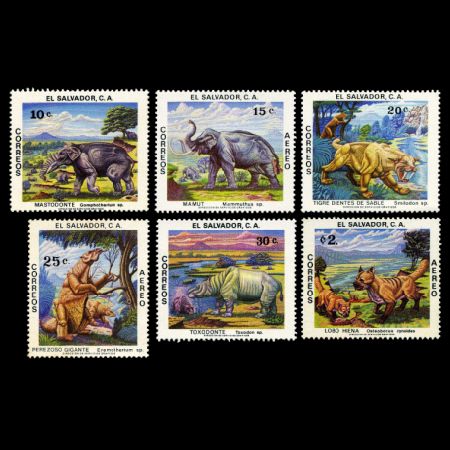
On September 7th, 1979, the Post of El Salvador issued a set of 6 stamps "Prehistoric Fauna from El Salvador", dedicated to prehistoric mammals that lived on the territory of the country during the Cenozoic Era. Three stamps of the set have land mail, three other airmail rate.
The set of stamps represents a new (in 1979) exhibit of "Prehistoric Life" in the Natural History Museum of El Salvador in San Salvador.
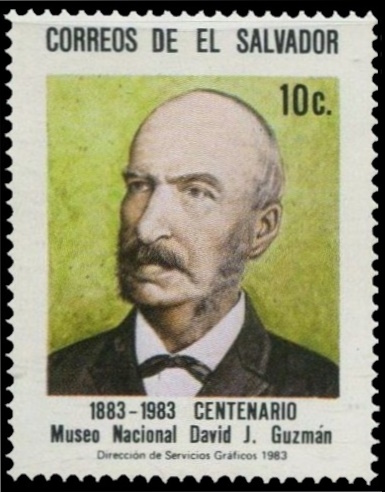 |
| David J. Guzmán on stamp of El Salvador 1983, MiNr.: 1479, Scott: 973. |
The Natural History Museum of El Salvador (MUHNES) was established in 1976.
The museum has three permanent exhibition rooms: "Rocks and Minerals", "Paleontology" and "Ecosystem".
The Hall of Paleontology: shows the remains of creatures that lived in El Salvador 10 million years ago.
The exhibition includes:
a skull replica of a saber-toothed tiger,
mastodon molars as well as impressions of fish, frogs and leaves found on sedimentary rocks from at the
province of San Vicente.
Also a mastodon molar found by David J. Guzmán, at Ilobasco, province of Cabañas.
No fossils of Dinosaurs have been found in El Salvador.
During the Mesozoic, this area was a marine area and the fossils found here include corals, algae, crabs, etc.
The first excavation of fossils in El Salvador were made in early 1900 by scientists David J. Guzman and Jorge Larde. In their papers, they make references to some sites where they found fossils.
In 1942, a paleontologist who studied Salvadorean prehistoric mammals, Dr. R. A. Stirton discovered seven extinct mammals that lived here.
During the 70's, a paleontologist named Steve Perrigo arrived at the Servicio de Parques Nacionales and Natural History Museum. He oversaw excavations at many sites which helped him confirm the variety of animals of Pleistocene age in Central America (the Pleistocene is the epoch of the Cenozoic era before the present Holocene epoch). In that period, the North and South of this continent were connected by Central America and intercontinental migration of animals was possible.
Mastodon (Gomphotherium) ("Welded Beast") is an extinct genus of proboscid which evolved in the Early Miocene of North America from 13.6503.6 Ma, living about 10 million years.
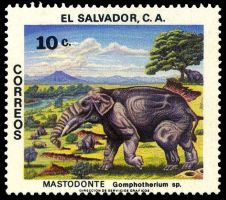 |
| Comphotherium on stamp of El Salvador 1979, MiNr.: 1289, Scott: 911. |
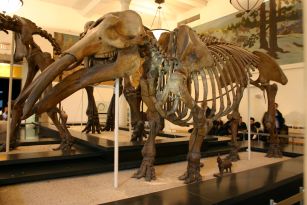 |
| Specimen of Gomphotherium productum at the AMNH |
Smilodon often called a saber-toothed cat or incorrectly a saber-toothed tiger, is an extinct genus of machairodonts. This saber-toothed cat was endemic to
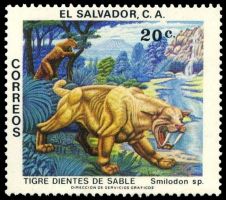 |
| Smilodon on stamp of El Salvador 1979" MiNr.: 1290, Scott: 912. |
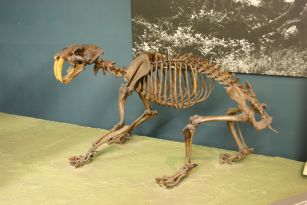 |
| Smilodon fatalis fossil at the National Museum of Natural History, Washington, DC |
Toxodon is an extinct mammal of the late Pliocene and Pleistocene epochs about 2.6 million to 16,500 years ago.
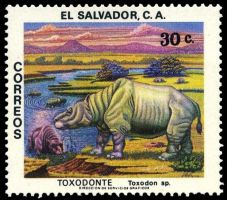 |
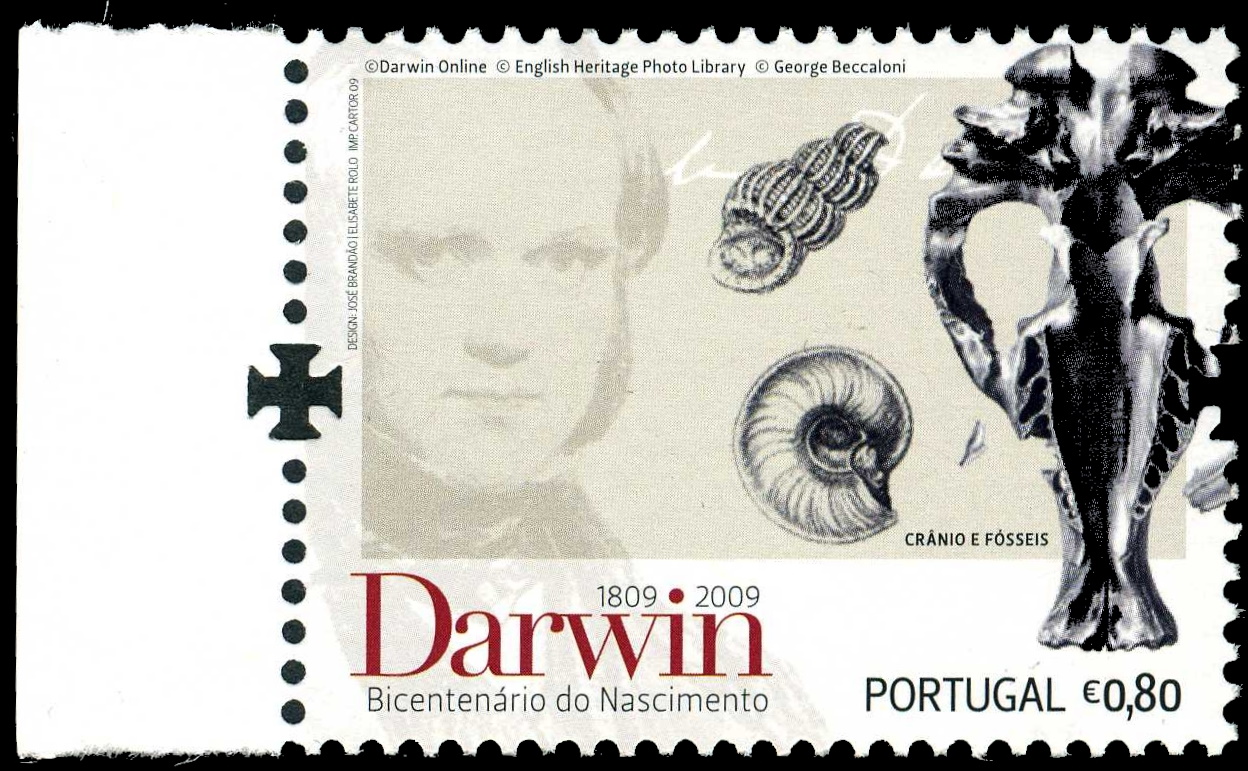 |
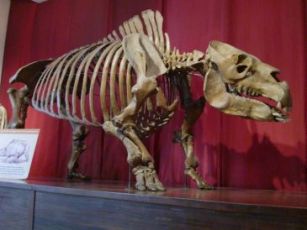 |
| Toxodon on stamp of El Salvador 1979 MiNr.: 1291, Scott: 913 | Charles Darwin and Toxodon skull on stamp of Portugal 2009, MiNr.: 3388, Scott: 3094. | Skeleton of Toxodon in Buenos Aires Nnatural History Museum. |
It was indigenous to South America, and was probably the most common large-hoofed mammal in South America at the time of its existence. Charles Darwin was one of the first to collect Toxodon fossils, after paying 18 pence for a T. platensis skull from a farmer in Uruguay.
In "The Voyage of the Beagle", Charles Darwin wrote
"November 26th - I set out on my return in a direct line for Monte Video. Having heard of some giant's bones at a neighbouring farmhouse on the Sarandis, a small stream entering the Rio Negro, I rode there accompanied by my host, and purchased for the value of eighteen pence the head of an animal equaling in size that of the hippopotamus. Mr Owen in a paper read before the Geological Society, has called this very extraordinary animal, Toxodon, from the curvature of its teeth."
Since Darwin discovered that the fossils of similar mammals of South America were different than those in Europe, he invoked many debates about the evolution and natural selection of animals. Toxodon was about 2.7 metres in body length, and about 1.5 metres high at the shoulder and resembled a heavy rhinoceros, with a short and vaguely hippopotamus-like head. Because of the position of its nasal openings, it is believed that Toxodon had a well-developed snout. It had a massive skeleton, which suggests that it supported a large muscular body. It had short stout legs with three functional toes, with most of the body weight being borne by the central toe.
The Columbian mammoth (Mammuthus emcolumbi) is an extinct species of elephant of the Quaternary period that appeared in North America (in the present
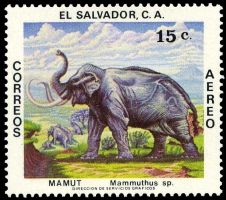 |
| Columbian mammoth on stamp of El Salvador 1979 MiNr.: 1292, Scott: C458 |
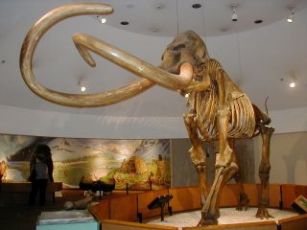 |
| Columbian mammoth in the Page Museum at the La Brea Tar Pits, Los Angeles |
The Columbian mammoth was one of the largest of the mammoth species and also one of the largest elephants to have ever lived, measuring 4 metres (13 ft) tall and weighing up to 10 metric tons (11 short tons). It was 10.7 feet (3.3 m) long at the shoulder, and had a head that accounted for 12 to 25 percent of its body weight. It had impressive, spiraled tusks which typically extended to 6.5 feet (2.0 m). Fossils of Columbian mammoth found in eastern country zone of El Salvador It was a herbivore, with a diet consisting of varied plant life ranging from grasses to conifers. It is also theorized that the Columbian mammoth ate the giant fruits of North America such as the Osage-orange, Kentucky coffee and honey locust as there was no other large herbivore in North America that could ingest these fruits.
Eremotherium carolinensis (Panamerican Ground Sloth) is an extinct genus of actively mobile ground sloth of the family Megatheriidae, endemic to North America and South America during the Pleistocene epoch.
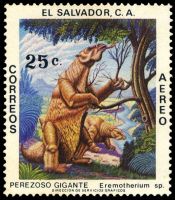 |
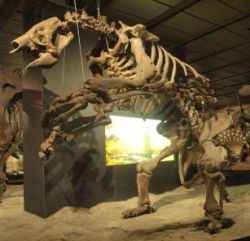 |
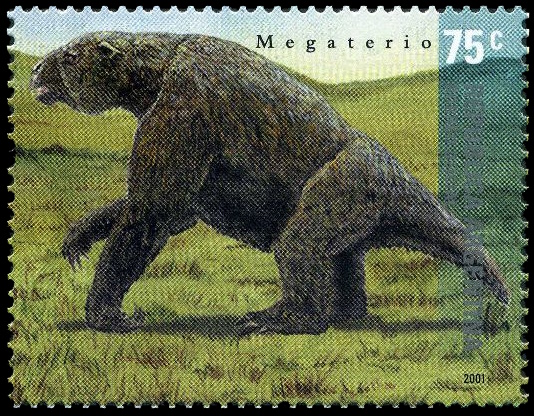 |
| Eremotherium on stamp of El Salvador 1979, MiNr.: 1293, Scott: 459. | Skeleton of Eremotherium at the Houston Museum of Natural Science (HMNS), Texas, USA. Image credit: Wikipedia | Megatherium on stamp of Argentina 2001, MiNr.: 2642, Scott: 2144a. |
This genus lived from approximately 1.8 million to 11,000 years ago. Fossils of this group have been found in many countries including El Salvador. One specimen from El Salvador is 7.6 meters tall - the tallest individual described from Central America!
Eremotherium was widespread in tropical and subtropical lowlands and lived there in partly open and closed landscapes, while its close relative Megatherium lived in more temperate climes of South America.
Both genera reached the size of today's elephants and were among the largest mammals in the Americas. Characteristic of Eremotherium was its robust physique with comparatively long limbs and front and hind feet especially for later representatives- three fingers. However, the skull is relatively gracile.
Like today's sloths, Eremotherium was purely herbivorous and was probably a mixed feeder that dined on leaves and grasses. Eremotherium was a generalist that could adapt its diet to the respective local and climatic conditions of many regions.
Eremotherium is among the most common mammals found in Pliocene to early
Holocene sites across tropical and equatorial regions of Central and South America.
It is known not only from El Salvador, but also from
Colombia to to
Guyana and Venezuela on the Caribbean coast
and along the Pacific coast as far as northern
Peru.
In North America, fossils of Eremotherium being found as far north as
South Carolina in the United States.
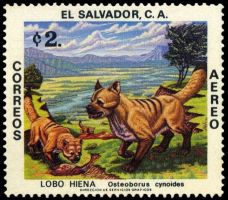 |
| Borophagus on stamp of El Salvador 1979 MiNr.: 1294, Scott: C460 |
Borophagus ("gluttonous eater") is an extinct genus of the subfamily Borophaginae, a group of canids endemic to North America from the early Miocene epoch through the Zanclean stage of the Pliocene epoch (23.3 to 3.6 mya). Borophagus, like other borophagines, are loosely known as "bone-crushing" or "hyena-like" dogs. Though not the most massive borophagine by size or weight, it had a more highly-evolved capacity to crunch bone than earlier, larger genera such as Epicyon, which seems to be an evolutionary trend of the group (Turner, 2004). During the Pliocene epoch, Borophagus began being displaced by Canis genera such as Canis edwardii and later by Canis dirus.
Products and associated philatelic items
| FDC | Philatelic Bulletin | |
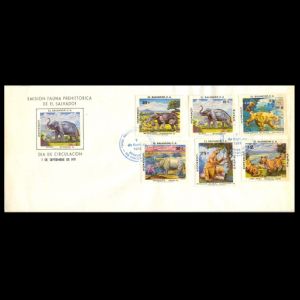 |
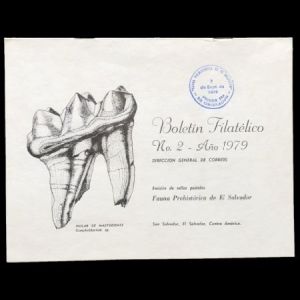 |
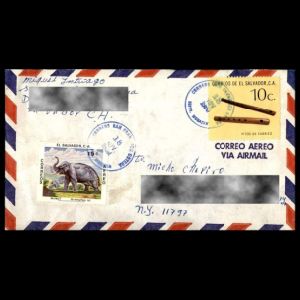 |

|
References
- Technical details and short description of the stamps: Oocites, Colnect.
- The Natural History Museum of El Salvador in San Salvador: ART ESSERE
- Mastodon: Wikipedia, Encyclopedia Britannica.
- Smilodon: Wikipedia,
- Toxodon: Wikipedia, Encyclopedia Britannica.
- The Columbian mammoth: Wikipedia,
- Eremotherium: Wikipedia,
- Borophagus: Wikipedia,
Acknowledgement
- Many thanks to Dr. Peter Voice, PhD Department of Geological and Environmental Sciences, Western Michigan University, USA, for review of a draft of this article and his very valuable comments.
- Many thanks to fellow collector Peter Brandhuber from Germany and Dr. Jon Noad from Canada for their help finding some information about these stamps, and scans of some philatelic items from their collections.
| <prev | back to index | next> |